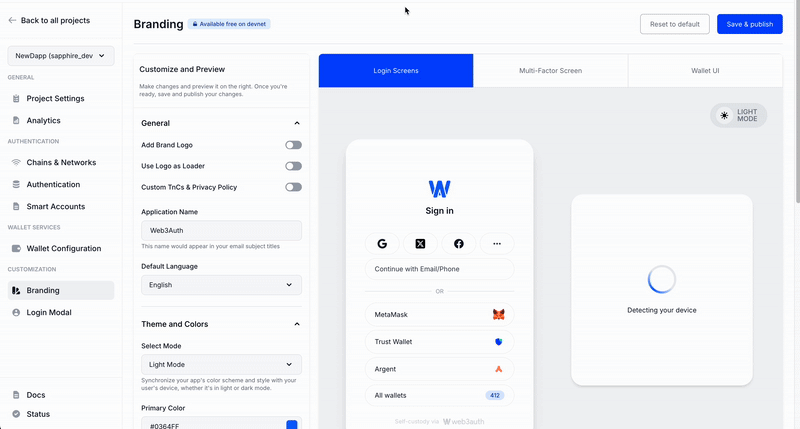Web3Auth v10 Whitelabeling Migration Guide
This guide focuses specifically on migrating whitelabeling and UI customization configurations from Web3Auth v7 to v10. This is a supplementary guide to the main v7 to v10 migration guide.
Overview
Whitelabeling and UI customization have been significantly streamlined in v10, focusing on dashboard configurations and a more direct approach to modal customization.
Migration Steps
1. Branding (v7 uiConfig): Moves to Dashboard
- Most general branding settings previously in the client-side
uiConfig(e.g.,appName,logoLight,logoDark,themecolors) are now primarily configured on the Web3Auth Developer Dashboard.
- Action: Transfer v7
uiConfigbranding to the dashboard. Client-sideuiConfigin v10Web3AuthOptionsis minimal, for overrides not covered by the dashboard.
2. Modal Login Method Display (v7 modalConfig in initModal()): New Structure in Web3AuthOptions
- Previously (v7): Customizing which login methods appear in the modal (and their
appearance/order) was done via
modalConfigininitModal()in v7. - Now (v10): This moves to
modalConfigwithinWeb3AuthOptions(at SDK instantiation). The structure is new, utilizingconnectors(e.g.,WALLET_CONNECTORS.AUTHfor social/email,WALLET_CONNECTORS.WALLETfor external wallets) and aloginMethodsobject within each connector. - Each login method (e.g.,
google,email_passwordless,metamask) is an object conforming toLoginMethodConfig, allowing you to setname,showOnModal,authConnectionId(for custom auth), etc.// v10: modalConfig in Web3AuthOptions
const web3AuthOptions: Web3AuthOptions = {
// ... other options
modalConfig: {
connectors: {
[WALLET_CONNECTORS.AUTH]: {
/* ... config for social/email ... */
},
[WALLET_CONNECTORS.WALLET]: {
/* ... config for external wallets ... */
},
},
},
}; - Action: Rebuild your modal display logic using the new
modalConfigstructure inWeb3AuthOptions. Refer to the v10LoginMethodConfigtype definition for all properties. Deprecated v7WALLET_ADAPTERSenum is replaced byWALLET_CONNECTORSand specific login method keys.
3. Auth Adapter Whitelabeling in v7: No longer supported
- In v7,
whiteLabelsettings in an@web3auth/openlogin-adapterinstance could customize intermediate auth screens (e.g., social login pop-ups). - In v10, passing this
whiteLabelconfiguration is no longer supported since there is no way to configure auth adapter settings. - Action: Remove v7
OpenloginAdapterwhiteLabelconfigurations. Ensure your dashboard branding is comprehensive.
Complete Migration Example
- v7 Whitelabeling
- v10 Dashboard Configuration
import { Web3Auth } from "@web3auth/modal";
import { OpenloginAdapter } from "@web3auth/openlogin-adapter";
const web3auth = new Web3Auth({
clientId: "YOUR_CLIENT_ID",
web3AuthNetwork: WEB3AUTH_NETWORK.SAPPHIRE_MAINNET,
privateKeyProvider,
uiConfig: {
appName: "W3A Heroes",
logoLight: "https://web3auth.io/images/web3auth-logo.svg",
logoDark: "https://web3auth.io/images/web3auth-logo---Dark.svg",
theme: {
primary: "#768729",
},
defaultLanguage: "en",
mode: "auto",
loginGridCol: 3,
primaryButton: "externalLogin",
},
});
const openloginAdapter = new OpenloginAdapter({
adapterSettings: {
whiteLabel: {
appName: "W3A Heroes",
logoLight: "https://web3auth.io/images/web3auth-logo.svg",
logoDark: "https://web3auth.io/images/web3auth-logo---Dark.svg",
theme: {
primary: "#768729",
},
},
},
});
web3auth.configureAdapter(openloginAdapter);
import { Web3Auth } from "@web3auth/modal";
// Most branding is configured on the Web3Auth Developer Dashboard
const web3auth = new Web3Auth({
clientId: "YOUR_CLIENT_ID",
web3AuthNetwork: WEB3AUTH_NETWORK.SAPPHIRE_MAINNET,
// Optional: Custom modal configuration for login methods
modalConfig: {
connectors: {
[WALLET_CONNECTORS.AUTH]: {
loginMethods: {
google: {
name: "Google",
showOnModal: true,
},
facebook: {
name: "Facebook",
showOnModal: true,
},
email_passwordless: {
name: "Email",
showOnModal: true,
},
},
},
},
},
});
Summary
This shift centralizes UI control on the dashboard and simplifies client-side SDK configuration for whitelabeling. The new approach provides better consistency across applications and easier maintenance of branding configurations.
Next Steps
Return to the main v7 to v10 migration guide to continue with other migration aspects like custom authentication and method name changes.